Unplugged: Holiday Guide 2019
 Happy Holidays! Boardgaming continues to make inroads to wider audiences, and there’s no better time to get (or get your friends and family) into the hobby than an extended holiday break. As we at GamerDad have done for the past 15+ years, it’s time for an annual rundown of recent boardgames well worth your time. Nothing beats the social aspect of in-person gaming with friends. Unlike many digital games, boardgames are timeless, just as good today as they will be years in the future. In that vein, feel free to delve into some past year’s guides like those for 2018, 2017, or 2016. You might not find all these titles at your local mega-mart but many can be found online or in a friendly local game store. Some may argue $50+ boardgames are expensive, but compare that to videogaming (and where multiple copies are required for multiplayer play) or heading out to the movies ($30+ for four people) and the economics of boardgaming shows their true value. For each game I’ve provided the number of players, an approximate MSRP (you might find it lower), and expected time for one game.
Happy Holidays! Boardgaming continues to make inroads to wider audiences, and there’s no better time to get (or get your friends and family) into the hobby than an extended holiday break. As we at GamerDad have done for the past 15+ years, it’s time for an annual rundown of recent boardgames well worth your time. Nothing beats the social aspect of in-person gaming with friends. Unlike many digital games, boardgames are timeless, just as good today as they will be years in the future. In that vein, feel free to delve into some past year’s guides like those for 2018, 2017, or 2016. You might not find all these titles at your local mega-mart but many can be found online or in a friendly local game store. Some may argue $50+ boardgames are expensive, but compare that to videogaming (and where multiple copies are required for multiplayer play) or heading out to the movies ($30+ for four people) and the economics of boardgaming shows their true value. For each game I’ve provided the number of players, an approximate MSRP (you might find it lower), and expected time for one game.
Games for and with kids
Games suitable for kids old enough to sit still and play, but contain enough interesting activity to entertain adults.
Heist: One team, One Mission (2-4p, $33, 5-15 minutes)
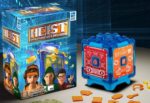 I stumbled upon this title at GenCon and it instantly won me over. The core of the game is a central “vault” shaped pillar with one button on each of four sides. Players take on a bank-robber role and then a group of plastic pieces is distributed. Once play starts, the talking vault gives out assignments such as “give the map to the money man” or “trade the drill for the flashlight.” Eventually the vault will say something like “Use the laptop” at which point the player currently possessing the laptop needs to push the button on their side of the vault. React too slowly, and an error is logged. As long as the players don’t log too many mistakes (around 3) the game continues, getting faster until the players “break into the vault” and win – causing lots of little plastic gold bars to fall out. It’s a fun, showy payoff to a frantic experience. There are multiple levels of play, giving players something to challenge them.
I stumbled upon this title at GenCon and it instantly won me over. The core of the game is a central “vault” shaped pillar with one button on each of four sides. Players take on a bank-robber role and then a group of plastic pieces is distributed. Once play starts, the talking vault gives out assignments such as “give the map to the money man” or “trade the drill for the flashlight.” Eventually the vault will say something like “Use the laptop” at which point the player currently possessing the laptop needs to push the button on their side of the vault. React too slowly, and an error is logged. As long as the players don’t log too many mistakes (around 3) the game continues, getting faster until the players “break into the vault” and win – causing lots of little plastic gold bars to fall out. It’s a fun, showy payoff to a frantic experience. There are multiple levels of play, giving players something to challenge them.
Valley of the Vikings (HABA) (2-4p, $30, 15-20 minutes)
 Winner of the German “Kid’s Game of the Year”, Valley of the Vikings has players taking turns to place their colored barrel in the middle of a board. They then flick a large wooden ball in an attempt to knock the barrels down. When a player knocks down a colored barrel, they are allowed to move that player’s token along a scoring track. When a token passes off the end of the scoring track, the track is “scored” assigning points based on the location of each player’s token. While anyone can flick the ball around and move the pieces, the bit of strategy in the game revolves around which tokens to move and in which order (since they skip over any filled spaces.) There’s just a smidge of strategy in choosing which barrels to target, while the physical nature of rolling the ball makes it entertaining for all ages.
Winner of the German “Kid’s Game of the Year”, Valley of the Vikings has players taking turns to place their colored barrel in the middle of a board. They then flick a large wooden ball in an attempt to knock the barrels down. When a player knocks down a colored barrel, they are allowed to move that player’s token along a scoring track. When a token passes off the end of the scoring track, the track is “scored” assigning points based on the location of each player’s token. While anyone can flick the ball around and move the pieces, the bit of strategy in the game revolves around which tokens to move and in which order (since they skip over any filled spaces.) There’s just a smidge of strategy in choosing which barrels to target, while the physical nature of rolling the ball makes it entertaining for all ages.
Sky magic (2-4p, $30 , 20-30 minutes)
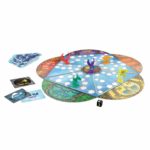 Sky Magic is a cooperative game where players attempt to rescue five mythical creatures from the center of a pentagonal board. Players roll the dice and then move the creatures along predetermined paths from cloud to cloud. However, if a cloud is rolled, entire sections of the map are blocked off or one of the five wedges are “flipped over.” The five sections are actually two different maps and folding a flap over like a book will change the path shown. If, after flipping, the creature is no longer on a cloud, it gets sent back to the middle of the board. If it ends up on a cloud even after turning the page, it gets to stay. Meanwhile the players have access to a few magic wands which can be used to prevent or reverse the effects of the cloud dice. Finally, there is a wand image on one side of the die which can cause players to lose one of their wands. They also serve as a timer and if 10 wands are lost the game ends. The box says 6+, but it could go a bit lower. Players take turns rolling and moving but all the creatures are available for anyone to move so a stray move here or there won’t necessarily be devastating.
Sky Magic is a cooperative game where players attempt to rescue five mythical creatures from the center of a pentagonal board. Players roll the dice and then move the creatures along predetermined paths from cloud to cloud. However, if a cloud is rolled, entire sections of the map are blocked off or one of the five wedges are “flipped over.” The five sections are actually two different maps and folding a flap over like a book will change the path shown. If, after flipping, the creature is no longer on a cloud, it gets sent back to the middle of the board. If it ends up on a cloud even after turning the page, it gets to stay. Meanwhile the players have access to a few magic wands which can be used to prevent or reverse the effects of the cloud dice. Finally, there is a wand image on one side of the die which can cause players to lose one of their wands. They also serve as a timer and if 10 wands are lost the game ends. The box says 6+, but it could go a bit lower. Players take turns rolling and moving but all the creatures are available for anyone to move so a stray move here or there won’t necessarily be devastating.
Party Games
The more, the merrier! Party games can accommodate at least 6 players and, unlike some games, tend to be more fun with more players.
Pictionary Air (2 teams, $20 , 15-60 minutes)
 The idea here is just what the name indicates – a game of Pictionary that is played by the drawer drawing pictures in the air. One person uses a phone to take video of another player using a light pen to draw in the air. This can then appear as a picture on the tablet (possibly also projecting it onto some monitor.) Teams then try to guess the word based on glowing virtual symbols drawn. One fun advantage of the game is how players can draw something around themselves and then interact with it to give their clue.
The idea here is just what the name indicates – a game of Pictionary that is played by the drawer drawing pictures in the air. One person uses a phone to take video of another player using a light pen to draw in the air. This can then appear as a picture on the tablet (possibly also projecting it onto some monitor.) Teams then try to guess the word based on glowing virtual symbols drawn. One fun advantage of the game is how players can draw something around themselves and then interact with it to give their clue.
Wits & Wagers: It’s Vegas Baby (2-5 players/teams, $30 , 30-40 minutes)
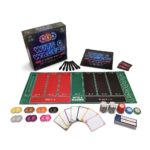 Wits and Wagers: It’s Vegas, Baby is a minor upgrade from the previous game. Players guess a numerical answer to a question and then all players bet on each other’s guesses. Players earn money (points) for correct answers and also for correct bets. What is new in this version (aside from the new questions) is the addition of a nice felt mat that gives players additional betting options (like a simple high/low 1:1 bet) and more money chips in the box than previous versions. Players can bet however much they wish, unlike the family version where players could only bet with your renewable chips (thus being less likely to bust completely.) At the moment, I think it is only available at Target.
Wits and Wagers: It’s Vegas, Baby is a minor upgrade from the previous game. Players guess a numerical answer to a question and then all players bet on each other’s guesses. Players earn money (points) for correct answers and also for correct bets. What is new in this version (aside from the new questions) is the addition of a nice felt mat that gives players additional betting options (like a simple high/low 1:1 bet) and more money chips in the box than previous versions. Players can bet however much they wish, unlike the family version where players could only bet with your renewable chips (thus being less likely to bust completely.) At the moment, I think it is only available at Target.
In addition to the above, most party gamers are timeless, you can’t go wrong with past years’ entries such as Codenames, Cheeky Monkey, Decrypto, Telestrations, One Night Ultimate Werewolf, etc…
Family Games
As your family gets older, they’ll have more fun with games with a bit more “punch”. Games in this category are playable by most any age level (so even the young ones can participate) but have enough strategy so that the older players have a chance to use strategy to increase their chances of winning.
Little Town (2-4 p, $30, 30-60 minutes)
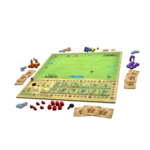 Little Town has players placing one of their workers onto the game board and then collecting resources from the eight surrounding squares. Most are empty, but wood, fish, and rock are collected from forests, ponds, and mountains respectively. Players can spend their resources to add buildings onto the board which either give an immediate benefit or an ongoing one for anybody collecting nearby resources. If you collect resources from another player’s building (the only way to get grain) you must pay them a coin. Meanwhile, players need to be sure to gather enough grain or fish to feed all their workers for each round. Players have secret goals which can be completed for points, such as feeding one’s workers solely with fish for a round. This is a game that plays quickly but still manages to provide a bit of meaty euro-game feel.
Little Town has players placing one of their workers onto the game board and then collecting resources from the eight surrounding squares. Most are empty, but wood, fish, and rock are collected from forests, ponds, and mountains respectively. Players can spend their resources to add buildings onto the board which either give an immediate benefit or an ongoing one for anybody collecting nearby resources. If you collect resources from another player’s building (the only way to get grain) you must pay them a coin. Meanwhile, players need to be sure to gather enough grain or fish to feed all their workers for each round. Players have secret goals which can be completed for points, such as feeding one’s workers solely with fish for a round. This is a game that plays quickly but still manages to provide a bit of meaty euro-game feel.
Age of Dirt: A Game of Uncivilization (2-5 p, $50, 45 minutes)
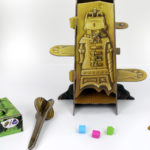 Age of Dirt is a tongue-in-cheek take on worker-placement games (games where players put workers onto a board locations to earn a benefit, eventually collecting the workers back again to reuse.) Here, players take on the role of a tribal leader, trying to convince tribal members to get out there and get things done. On a turn, players can choose to put one or two workers into a box (which then hides the number of works inside) or a player can choose to take the contents of one box and dump them into “the passage.” This is a tower with cardboard slots inside so that workers dumped into the tower may become trapped. When a box is dumped into the tower, only the workers that fall out the bottom earn the resources granted by the box (such as wood, berries, fur, or rocks.) Players have a special one-use drum piece which lets them give the tower a good “whack” if their worker pieces get stuck at an inopportune time. Players also have a spear, which is useful in fighting off animals (especially when hunting furs) which would otherwise kill off their worker. Both spears and drums are one-use but players can reuse them using a wood resource. In addition to the standard resources, there is also a box entitled “Love Shack.” When dumped into the tower, each pair of workers spilling out the bottom grants that player an additional worker to use in future rounds. Two players with singleton workers can agree to combine their efforts and each receive an extra worker token. Players are primarily vying to obtain the required resources listed on cards (either ones in hand or common ones on the table.) Each card grants a special ability (either immediate or ongoing) as well as rock stars. The first player to earn 10 rock stars wins the game. The various card abilities (as well as each player’s starting “tribal ability,” which can be earned) add some nice variety and long term strategy to the game. There’s also an event deck which helps to shake things up from time to time and can occasionally help players who are behind catch up to the leader. This is a great stepping stone game for younger kids (even 7 or 8) to work their way up to slightly more complex fare.
Age of Dirt is a tongue-in-cheek take on worker-placement games (games where players put workers onto a board locations to earn a benefit, eventually collecting the workers back again to reuse.) Here, players take on the role of a tribal leader, trying to convince tribal members to get out there and get things done. On a turn, players can choose to put one or two workers into a box (which then hides the number of works inside) or a player can choose to take the contents of one box and dump them into “the passage.” This is a tower with cardboard slots inside so that workers dumped into the tower may become trapped. When a box is dumped into the tower, only the workers that fall out the bottom earn the resources granted by the box (such as wood, berries, fur, or rocks.) Players have a special one-use drum piece which lets them give the tower a good “whack” if their worker pieces get stuck at an inopportune time. Players also have a spear, which is useful in fighting off animals (especially when hunting furs) which would otherwise kill off their worker. Both spears and drums are one-use but players can reuse them using a wood resource. In addition to the standard resources, there is also a box entitled “Love Shack.” When dumped into the tower, each pair of workers spilling out the bottom grants that player an additional worker to use in future rounds. Two players with singleton workers can agree to combine their efforts and each receive an extra worker token. Players are primarily vying to obtain the required resources listed on cards (either ones in hand or common ones on the table.) Each card grants a special ability (either immediate or ongoing) as well as rock stars. The first player to earn 10 rock stars wins the game. The various card abilities (as well as each player’s starting “tribal ability,” which can be earned) add some nice variety and long term strategy to the game. There’s also an event deck which helps to shake things up from time to time and can occasionally help players who are behind catch up to the leader. This is a great stepping stone game for younger kids (even 7 or 8) to work their way up to slightly more complex fare.
Machi Koro Legacy (2-4 p, $50, 30-45 minutes)
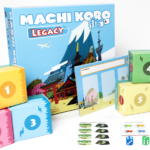 Machi Koro is an excellent game that I like to describe as something like Monopoly without the board. Players roll dice and earn coins if they have cards matching the value. Some cards earn money on everyone’s turn, others only on the active player’s turn, and some actually steal money from the active player. After rolling, the active player can buy one card (from the piles in the middle) to add to their collection. However, players can instead buy one of their special ability cards (which range from cheap to very expensive.) The first player to buy all their special ability cards wins the game. Machi Koro Legacy initially plays like the base game, but the Legacy portion kicks in at the end of each game. There is a booklet that is used to tell a bit of an overarching story and it describes the result of the game and brings in new cards and rules changes that will be implemented in future games. This “Legacy” style of game has been very popular in past years, and it provides gamers with a game that slowly evolves over time. It is almost like adding little mini-expansions in for each game, but the best Legacy games also provide distinct decision trees that have consequences down the line so that every group will have a slightly different gaming experience over the life of the game. Many Legacy games remain replayable even after the overarching story is played out – giving players their own unique copy of the game. In Machi Koro Legacy, some of the changes will be permanent, while others have the possibility of being reversed if desired after completing the story arc. Legacy games are quite fun, and offer a new way for players to become even more connected to their game.
Machi Koro is an excellent game that I like to describe as something like Monopoly without the board. Players roll dice and earn coins if they have cards matching the value. Some cards earn money on everyone’s turn, others only on the active player’s turn, and some actually steal money from the active player. After rolling, the active player can buy one card (from the piles in the middle) to add to their collection. However, players can instead buy one of their special ability cards (which range from cheap to very expensive.) The first player to buy all their special ability cards wins the game. Machi Koro Legacy initially plays like the base game, but the Legacy portion kicks in at the end of each game. There is a booklet that is used to tell a bit of an overarching story and it describes the result of the game and brings in new cards and rules changes that will be implemented in future games. This “Legacy” style of game has been very popular in past years, and it provides gamers with a game that slowly evolves over time. It is almost like adding little mini-expansions in for each game, but the best Legacy games also provide distinct decision trees that have consequences down the line so that every group will have a slightly different gaming experience over the life of the game. Many Legacy games remain replayable even after the overarching story is played out – giving players their own unique copy of the game. In Machi Koro Legacy, some of the changes will be permanent, while others have the possibility of being reversed if desired after completing the story arc. Legacy games are quite fun, and offer a new way for players to become even more connected to their game.
Tiny Epic Mechs (1-4 p, $25, 30-60 minutes)
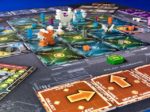 Gamelyn’s newest in its Tiny Epic line is Tiny Epic Mechs. This is an arena combat game where players use cards to program in four actions at a time. Each card has a direction, as well as an action to perform (like gather energy, lay down traps, etc…) Players begin the game as a lowly meeple able to hold up to two weapons as they move around. As they collect energy they can power up their meeples to enter their own tiny mech (giant robot.) This allows the use of even more powerful weapons. Players leave mines (of secretly placed levels 1 to 4 damage) and turrets around the board to hinder their opponents, but these also help to collect energy. When a player is defeated in combat, they are reduced to a lowly meeple again but are able to take advantage of all of their pieces still on the board. The game ends after six rounds of play with points awarded for doing damage, attacking, and being the person to deliver a knockout punch.
Gamelyn’s newest in its Tiny Epic line is Tiny Epic Mechs. This is an arena combat game where players use cards to program in four actions at a time. Each card has a direction, as well as an action to perform (like gather energy, lay down traps, etc…) Players begin the game as a lowly meeple able to hold up to two weapons as they move around. As they collect energy they can power up their meeples to enter their own tiny mech (giant robot.) This allows the use of even more powerful weapons. Players leave mines (of secretly placed levels 1 to 4 damage) and turrets around the board to hinder their opponents, but these also help to collect energy. When a player is defeated in combat, they are reduced to a lowly meeple again but are able to take advantage of all of their pieces still on the board. The game ends after six rounds of play with points awarded for doing damage, attacking, and being the person to deliver a knockout punch.
Family Strategy
These are great games for most families – or a group of adults looking for a medium-weight game to play casually around the table to end an evening. These are a notch up in complexity kid’s or party games, but are simple enough for teens or preteens to enjoy.
New Frontiers (2-5 p, $50, 45-75 minutes)
 The popular card game, Race for the Galaxy, has been turned into a fancy boardgame called New Frontiers . It has the same balance of settling planets, purchasing tech upgrades, producing goods, and shipping them for points. The active player chooses a role, gains a slight bonus, and then all the other players also take advantage of that role. Roles include gaining planets, settling them (making them active,) buying upgrades (new game abilities,) and producing and selling goods for points or money. Unlike the card game, where players choose upgrades from a hand of cards, the New Frontiers boardgame has all the upgrade options available from the start of the game. With most of the materials already on the board at the start, it keeps the complexity of the game down a little bit, especially on the 2nd or 3rd plays through the game. I personally feel the ginormous colored plastic goods tokens are a bit over-the-top but I have to admit they make it more attractive to casual players by adding a bit of bling to the game.
The popular card game, Race for the Galaxy, has been turned into a fancy boardgame called New Frontiers . It has the same balance of settling planets, purchasing tech upgrades, producing goods, and shipping them for points. The active player chooses a role, gains a slight bonus, and then all the other players also take advantage of that role. Roles include gaining planets, settling them (making them active,) buying upgrades (new game abilities,) and producing and selling goods for points or money. Unlike the card game, where players choose upgrades from a hand of cards, the New Frontiers boardgame has all the upgrade options available from the start of the game. With most of the materials already on the board at the start, it keeps the complexity of the game down a little bit, especially on the 2nd or 3rd plays through the game. I personally feel the ginormous colored plastic goods tokens are a bit over-the-top but I have to admit they make it more attractive to casual players by adding a bit of bling to the game.
Era: Medieval Age (1-4 p, $70, 45-60 minutes)
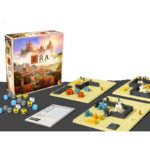 The idea of taking a small civilization and building up a bustling economy by the end of a game is one of the more satisfying game experiences. One of the holy grails for boardgaming is to pull that off within a short period of time. The entirely overproduced Era: Medieval Age makes a worthy stab at the goal. This game also has players simultaneously rolling their own dice (Yahtzee-reroll style) to accumulate resources (stone, wood, wheat, trade goods.) Players then use the resources to build new buildings, which are actual plastic pieces plugged into their board full of holes (think placing ships in Battleship.) These buildings slowly form a city complete with buildings and walls. In addition to looking spiffy, they buildings provide new abilities to their owner. Some grant additional dice to roll, others modify the game or board in some way, and others are there simply to score points at the end of the game. The game has four colors of dice that can be earned, each with a bit of a specialty. Yellow dice grant food (required to feed your “dice” each round one food per die), blue dice provide goods and culture (points), white dice provide resources and culture but can also occasionally grant die rerolls. Finally, grey dice provide attack and defense. Players with more swords rolled than other players can steal a good. This means players focusing on swords can end up preying on others (who hopefully have focused their development in other areas) so buyer beware if your family frowns on that sort of thing. Building the cool plastic city is more than just looks. Some game effects are triggered based on which buildings are near or touching others, and players who are able to build a complete (walls all the way around) city area earn double points at the end of the game.
The idea of taking a small civilization and building up a bustling economy by the end of a game is one of the more satisfying game experiences. One of the holy grails for boardgaming is to pull that off within a short period of time. The entirely overproduced Era: Medieval Age makes a worthy stab at the goal. This game also has players simultaneously rolling their own dice (Yahtzee-reroll style) to accumulate resources (stone, wood, wheat, trade goods.) Players then use the resources to build new buildings, which are actual plastic pieces plugged into their board full of holes (think placing ships in Battleship.) These buildings slowly form a city complete with buildings and walls. In addition to looking spiffy, they buildings provide new abilities to their owner. Some grant additional dice to roll, others modify the game or board in some way, and others are there simply to score points at the end of the game. The game has four colors of dice that can be earned, each with a bit of a specialty. Yellow dice grant food (required to feed your “dice” each round one food per die), blue dice provide goods and culture (points), white dice provide resources and culture but can also occasionally grant die rerolls. Finally, grey dice provide attack and defense. Players with more swords rolled than other players can steal a good. This means players focusing on swords can end up preying on others (who hopefully have focused their development in other areas) so buyer beware if your family frowns on that sort of thing. Building the cool plastic city is more than just looks. Some game effects are triggered based on which buildings are near or touching others, and players who are able to build a complete (walls all the way around) city area earn double points at the end of the game.
Planet (2-4 p, $40, 30-45 minutes)
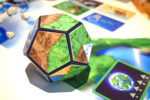 In perhaps the most unique game of the year, Planet challenges players to form a “world” of their own by placing tiles onto a personal, physical, 3-dimensional dodecahedron (12-sides). Each round, players select a tile and add it somewhere onto their “planet” where it sticks due to magnets. The tiles contain one or more sections of different terrain (ice, plains, water, etc…) The game is played over several rounds. A few rows of scoring cards are placed such that they line up with each round. Players attempt to build up their planets in such a way as to accomplish the requirements of the scoring cards in order to win points. Goals typically revolve around forming specific combinations of terrain (largest section of water, most plains adjacent to ice, etc…) All the goal cards are known at the start of the game, so players can plan out a path to try to get as many point cards as they can along the way. While the game does favor players with a bit of spatial reasoning, the rules and actions are straightforward, making this unique game entirely suited for family play.
In perhaps the most unique game of the year, Planet challenges players to form a “world” of their own by placing tiles onto a personal, physical, 3-dimensional dodecahedron (12-sides). Each round, players select a tile and add it somewhere onto their “planet” where it sticks due to magnets. The tiles contain one or more sections of different terrain (ice, plains, water, etc…) The game is played over several rounds. A few rows of scoring cards are placed such that they line up with each round. Players attempt to build up their planets in such a way as to accomplish the requirements of the scoring cards in order to win points. Goals typically revolve around forming specific combinations of terrain (largest section of water, most plains adjacent to ice, etc…) All the goal cards are known at the start of the game, so players can plan out a path to try to get as many point cards as they can along the way. While the game does favor players with a bit of spatial reasoning, the rules and actions are straightforward, making this unique game entirely suited for family play.
Serious Strategy Games
I typically mention a few games for the more serious boardgamer. These have a few more rules and take a bit longer to play. In a year of contrasts I’m featuring one fully cooperative game and two all-out wargames. None are as complex as past years’ serious strategy recommendations, but best played by people willing to put up with a few rules in order to find a game that has substance.
Mage Knight: Ultimate Edition (1-5 p, $125, 150 minutes)
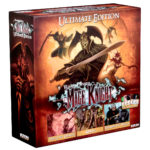 Starring in our 2012 Holiday Guide, Mage Knight drew a following with a few expansions added as the game matures. Mage Knight is back this year in a brand new Ultimate Edition which includes all three past expansions, a few all-new cards, very nice painted minis, and (perhaps the most useful) an all-new combined rulebook for the base game and its expansions. If you’re unfamiliar with the game, Mage Knight is an adventure game for one to four players. Players are represented by a figure on a board consisting of hexagons that are explored as the game progresses. Mage knight is a deckbuilding game, which means players start with a (very) small deck of cards and slowly improve that deck by acquiring new cards as the game progresses. Players take turns using cards to move about the board, attack creatures, recruit minions, and gather resources. When a player runs out of cards all other players get one last turn before the end of the round. Card decks are then reshuffled and a new round begins with players gaining access to the cards they recently acquired. Every card has two abilities, a basic one and a more powerful option if resources are spent. This provides many interesting decisions for players but leads to the games main drawback, its length. While a typical game only lasts three to six rounds (depending on the scenario) it will take a good two hours for even a short game. In its defense the game is worth it. What pushes it over the top for inclusion in this guide is the game’s robust solo and cooperative play options. As any parent with young kids knows, finding time for a multiplayer game is often difficult.
Starring in our 2012 Holiday Guide, Mage Knight drew a following with a few expansions added as the game matures. Mage Knight is back this year in a brand new Ultimate Edition which includes all three past expansions, a few all-new cards, very nice painted minis, and (perhaps the most useful) an all-new combined rulebook for the base game and its expansions. If you’re unfamiliar with the game, Mage Knight is an adventure game for one to four players. Players are represented by a figure on a board consisting of hexagons that are explored as the game progresses. Mage knight is a deckbuilding game, which means players start with a (very) small deck of cards and slowly improve that deck by acquiring new cards as the game progresses. Players take turns using cards to move about the board, attack creatures, recruit minions, and gather resources. When a player runs out of cards all other players get one last turn before the end of the round. Card decks are then reshuffled and a new round begins with players gaining access to the cards they recently acquired. Every card has two abilities, a basic one and a more powerful option if resources are spent. This provides many interesting decisions for players but leads to the games main drawback, its length. While a typical game only lasts three to six rounds (depending on the scenario) it will take a good two hours for even a short game. In its defense the game is worth it. What pushes it over the top for inclusion in this guide is the game’s robust solo and cooperative play options. As any parent with young kids knows, finding time for a multiplayer game is often difficult.
Cloudspire (1-4 p, $130, 90-180 minutes)
 Chip Theory Games is a small company that focuses on deep games with high quality components that provide the player with many, many different strategies to explore. Their biggest game, Too Many Bones, has players rolling piles of dice as they try to cooperatively defeat a scenario is a role-playing style game of unique character customization. They have taken their standard high quality components and diverse gameplay options and attempted to create a MOBA style tower defense boardgame. MOBA games are a genre of videogames (League of Legends or Hero of the Storm) which have gained popularity in the past few years (one could argue that League of Legends is perhaps currently the most popular e-sport.) In the boardgame, Cloudspire, players manage a particular side, a tower, minions, and a hero such that their base is the last one standing in a vs battle (2 to 4 players.) Each player sends out “minion” pieces that progress along automated paths in order to march over and damage other player’s towers. Meanwhile, the other players are trying to maneuver their hero into place to kill these minions as they come, providing more resources and leveling up the hero. Finally, the tower itself can be upgraded in many ways, and all of the above is slightly different for each of the factions that can be played. In addition to the standard competitive play, there are 16 solo scenarios (along with a thematic story) and 8 two player cooperative scenarios. The cooperative games are of great interest to me, as my son and I can then play together against the pre-programmed boardgame AI. If you’re interested in the title, note that since they are a small company, all Chip Theory titles (like Cloudspire) are only available through their website.
Chip Theory Games is a small company that focuses on deep games with high quality components that provide the player with many, many different strategies to explore. Their biggest game, Too Many Bones, has players rolling piles of dice as they try to cooperatively defeat a scenario is a role-playing style game of unique character customization. They have taken their standard high quality components and diverse gameplay options and attempted to create a MOBA style tower defense boardgame. MOBA games are a genre of videogames (League of Legends or Hero of the Storm) which have gained popularity in the past few years (one could argue that League of Legends is perhaps currently the most popular e-sport.) In the boardgame, Cloudspire, players manage a particular side, a tower, minions, and a hero such that their base is the last one standing in a vs battle (2 to 4 players.) Each player sends out “minion” pieces that progress along automated paths in order to march over and damage other player’s towers. Meanwhile, the other players are trying to maneuver their hero into place to kill these minions as they come, providing more resources and leveling up the hero. Finally, the tower itself can be upgraded in many ways, and all of the above is slightly different for each of the factions that can be played. In addition to the standard competitive play, there are 16 solo scenarios (along with a thematic story) and 8 two player cooperative scenarios. The cooperative games are of great interest to me, as my son and I can then play together against the pre-programmed boardgame AI. If you’re interested in the title, note that since they are a small company, all Chip Theory titles (like Cloudspire) are only available through their website.
Stocking Stuffers
Got a bit of space left in your sock over the fireplace? Here’s a great small game that you might be able to cram into the toe…
Castles of Burgundy: The Dice Game (1-5 p, $15, 15-30 minutes)
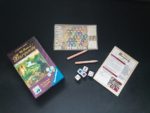 The “roll and write” genre of game has become a phenomenon in the past few years. There are more and more dice-focused games released each year. Castles of Burgundy: The Dice Game has been out a little while but I just discovered this gem that is a dice-based version of one of the all-time classic boardgames (The Castles of Burgundy.) In the dice version, each player has a map of hexagons, divided into clusters of the same color. Each round, five dice are rolled. Two dice show a color, two show a number, and the fifth serves as a time marker, advancing the game clock one or two steps each roll. After the dice are rolled, players simultaneously choose one of the color and one of the number dice to use to fill in their personal board. Some colors only work with specific numbers (blue rivers need a 5 or 6, for example) while others can be combined with any number (clusters of yellow fields can have any number but no duplicates in a given field.) After marking in a hex, if a player has completed filling in one area (typically 2 to 5 hexagons in size) they score points (larger areas and areas completed earlier score more points.) Players also get a benefit depending on the color. This could be in the form of extra points, opportunities to write in TWO hexagons in a round, or ways to adjust the numbers or colors rolled on the dice. There is also a race to fill in all hexes of one color on the board (this would entail completing several different groups of hexes of the same color.) The first (and second) player to fill in all of a color gain bonus points. After a number of rounds (determined by the time-maker die, the game stops and players add up their points. No points are gained for any same-color clusters of hexagons that aren’t completely finished. I enjoy the game quite a bit. It manages to pack in some fun tactical decisions (which hexes should I fill in this round) with some nice longer-term strategies (which clusters should I try to focus on…) all in a box that almost (but not quite) fits in my pocket. It doesn’t hurt that it it also plays pretty well as a solo game (just trying for a high score.)
The “roll and write” genre of game has become a phenomenon in the past few years. There are more and more dice-focused games released each year. Castles of Burgundy: The Dice Game has been out a little while but I just discovered this gem that is a dice-based version of one of the all-time classic boardgames (The Castles of Burgundy.) In the dice version, each player has a map of hexagons, divided into clusters of the same color. Each round, five dice are rolled. Two dice show a color, two show a number, and the fifth serves as a time marker, advancing the game clock one or two steps each roll. After the dice are rolled, players simultaneously choose one of the color and one of the number dice to use to fill in their personal board. Some colors only work with specific numbers (blue rivers need a 5 or 6, for example) while others can be combined with any number (clusters of yellow fields can have any number but no duplicates in a given field.) After marking in a hex, if a player has completed filling in one area (typically 2 to 5 hexagons in size) they score points (larger areas and areas completed earlier score more points.) Players also get a benefit depending on the color. This could be in the form of extra points, opportunities to write in TWO hexagons in a round, or ways to adjust the numbers or colors rolled on the dice. There is also a race to fill in all hexes of one color on the board (this would entail completing several different groups of hexes of the same color.) The first (and second) player to fill in all of a color gain bonus points. After a number of rounds (determined by the time-maker die, the game stops and players add up their points. No points are gained for any same-color clusters of hexagons that aren’t completely finished. I enjoy the game quite a bit. It manages to pack in some fun tactical decisions (which hexes should I fill in this round) with some nice longer-term strategies (which clusters should I try to focus on…) all in a box that almost (but not quite) fits in my pocket. It doesn’t hurt that it it also plays pretty well as a solo game (just trying for a high score.)
Love Letter (2-4p, $12, 20min)
 Appearing in my 2013 guide, I need to mention Love Letter again, as it has become a great hit within my household due to its quick gameplay. This game consists of a deck of only 16 cards and a few tokens. Players start with a single card in their hand. On their turn they draw a card and then play one. The goal is to end the round with the highest valued card. Simple enough, until the special ability of each card is taken into account. One card allows a player to look at another’s hand. Another card will eliminate a player if you can correctly guess what card they hold. The highest valued card is, of course, the most coveted but if you ever are forced to discard it, you are instantly out of that round. When a player has won a specified number of rounds, they are declared the winner. Love letter is a great, short game of deduction and bluffing – just the right size for someone’s Christmas stocking.
Appearing in my 2013 guide, I need to mention Love Letter again, as it has become a great hit within my household due to its quick gameplay. This game consists of a deck of only 16 cards and a few tokens. Players start with a single card in their hand. On their turn they draw a card and then play one. The goal is to end the round with the highest valued card. Simple enough, until the special ability of each card is taken into account. One card allows a player to look at another’s hand. Another card will eliminate a player if you can correctly guess what card they hold. The highest valued card is, of course, the most coveted but if you ever are forced to discard it, you are instantly out of that round. When a player has won a specified number of rounds, they are declared the winner. Love letter is a great, short game of deduction and bluffing – just the right size for someone’s Christmas stocking.
Expansions
If you already have favorite games in your collection, you may be pleasantly surprised to find there are expansions available to breathe new life into old favorites. Decrypto (an excellent secret communication party game) has an expansion, LaserDrive , which contains a new deck of cards. One of these is drawn each round and the clue giver must give their clues such that they ALSO obey the rule on the card (such as clues have to start with the letter A, they have to be movie titles, they have to be tourist attractions, etc…) This does level up the difficulty of the game and create some fun confusion on both sides. There’s always a new map around the corner for the excellent family title, Ticket to Ride. This year there are a new set of maps (Japan – where players play a bullet train tracks as a group, and Italy – where players have to deal with ferry routes and are trying to connect regions rather than cities.) The other Ticket to Ride release is Ticket to Ride: London, the second game in the series that has been adjusted for super-quick play (under 15 minutes!) I plugged One Night Ultimate Werewolf (a version of the popular deduction game that is played with only one “night” scene) a few years ago, and was excited to see the new stand-alone One Night Ultimate Super Villains as not everyone I play with appreciates the werewolf theme.
Conclusions
No matter what toys and presents the holidays bring, be sure to keep time in your schedule for playing with friends and family. While the games here come highly recommended to provide fun for a wide range of players, there are plenty other choices available. Ask your local game store, a boardgaming friend, or check some of our past recommendations.





Discussion Area - Leave a Comment